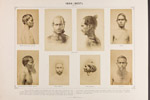A World Getting Smaller
As photography became commonplace, the wide availability of images offered Americans an intimate view of faraway people, places, and events. Some of these were photographs mounted as illustrations on the pages of scientific books. Others were popular commercial products providing entertainment and sometimes propaganda. Racism permeated both popular and scientific culture, and as a result, photography often served the cause and ideology of white supremacy.
 |
Unidentified. Races of Mankind. [zoom] Albumen prints Dammann, Carl and Frederick W. Ethnological Photographic Gallery of the Various Races of Men. Trubner, London, 1875. This early example of photographic ethnology used portraits to categorize the “various races of man.” This English edition, adapted from the German edition of 1873, presents a racist evolutionary narrative characteristic of the time, starting with “civilized” Europeans and ending with Australians and Polynesians. |
 |
Photograph by Milton M. Miller, published by E. & H. T. Anthony. "Mandarin In Sedan Chair and Attendants,” ca. 1862. [zoom] Albumen print, stereograph mount E. & H. T. Anthony was one of largest producers of stereographs in America. The firm assembled a tremendous catalog of stereographs from around the world by purchasing negatives from photographers, both amateur and professional. Milton M. Miller’s “Scenes from China” was a popular Anthony series. |